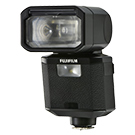
This clip-on flash unit has a Guide Number of 50/164 (ISO 100, m/ft.) and supports FP (high-speed sync), allowing it to be used at shutter speeds that exceed the flash sync speed. Powered by four AA batteries or an optional EF-BP1 battery pack, it supports manual and TTL flash control and auto power zoom in the range 24–105 mm (35 mm format equivalent) and features FUJIFILM optical wireless flash control, allowing it to be used as a master or remote flash unit for remote wireless flash photography. The flash head can be rotated 90° up, 10° down, 135° left, or 180° right for bounce lighting.
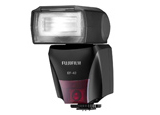
This clip-on flash unit (powered by four AA batteries) has a Guide Number of 42/137 (ISO 100, m/ft.) and supports TTL flash control and auto power zoom in the range 24–105 mm (35 mm format equivalent). The flash head can be rotated 90° up, 180° left, or 120° right for bounce lighting.
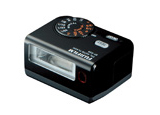
This clip-on flash unit has a Guide Number of 20/65 (ISO 100, m/ft.).

This clip-on flash unit (powered by two AA batteries) has a Guide Number of 20/65 (ISO 100, m/ft.) and supports TTL flash control. The flash head can be rotated upwards 90° for bounce lighting.
External flash units are more powerful than their built-in counterparts. Some can function as master flash units controlling remote units via optical wireless flash control.
Test firing may sometimes be unavailable, for example when the camera setup menu is displayed.
Connect the flash unit and select [FLASH SETTING] > [FLASH FUNCTION SETTING] in the camera shooting menu to display flash options. The options available vary with the status of the connected unit.
To prevent the built-in flash firing when a shoe-mounted flash unit is attached, select [OFF] for [FLASH SETTING] > [Built-In Flash].
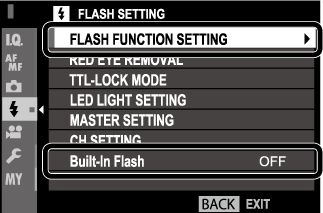
[SYNC TERMINAL] will be displayed if [OFF] is selected for [FLASH SETTING] > [Built-In Flash] and no supported shoe-mounted flash is attached.
Flash units that support burst mode can be used for burst photography.
Third-party studio flash commanders compatible with the FUJIFILM flash system can now be used. For more information, see the documentation provided your studio flash unit.
The following options are available with optional shoe-mounted flash units.
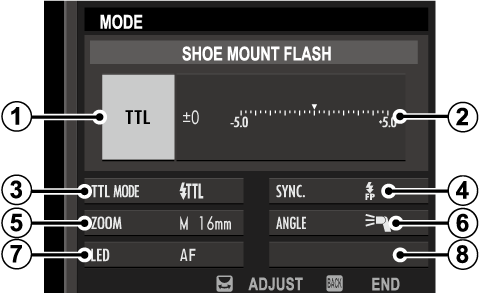
 Flash control mode
Flash control mode
The flash control mode selected with the flash unit. This can in some cases be adjusted from the camera; the options available vary with the flash.
 ).
). ).
). Flash compensation/output
Flash compensation/output
The options available vary with flash control mode.
 Flash mode (TTL)
Flash mode (TTL)
Choose a flash mode for TTL flash control.The options available vary with the shooting mode ([P], [S], [A], or [M]) selected.
 icon displayed when the shutter button is pressed halfway indicates that the flash will fire when the photo is taken.
icon displayed when the shutter button is pressed halfway indicates that the flash will fire when the photo is taken. Sync
Sync
Control flash timing.
 Zoom
Zoom
The angle of illumination (flash coverage) for units that support flash zoom. Some units allow the adjustment to be made from the camera. Select [AUTO] to automatically match coverage to focal length when using optional conversion lenses.
 Lighting
Lighting
If the unit supports this feature, choose from the options below.
 LED light
LED light
Choose how the built-in LED light functions during still photography (compatible units only). It can function as a catchlight ([CATCHLIGHT]), as an AF-assist illuminator ([AF ASSIST]), or as both a catchlight and an AF-ASSIST illuminator ([AF ASSIST+CATCHLIGHT]). Choose OFF to disable the LED during photography.
 Number of flashes
Number of flashes
Choose the number of times the flash fires each time the shutter is released in [MULTI] mode. Full value may not be applied if limits of flash control system are exceeded.
 Frequency
Frequency
Choose the frequency at which the flash fires in [MULTI] mode. Full value may not be applied if limits of flash control system are exceeded.
The options at right will be displayed if the unit is currently functioning as master flash for FUJIFILM optical wireless remote flash control.
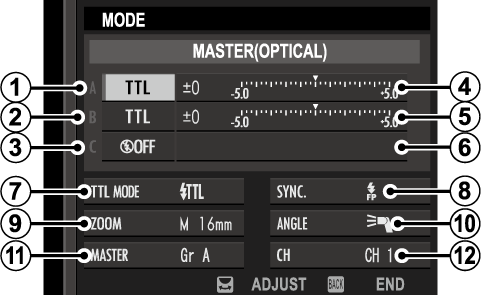
The master and remote units can be placed in up to three groups (A, B, and C) and flash mode and flash level adjusted separately for each group. Four channels are available for communication between the units; separate channels can be used for different flash systems or to prevent interference when multiple systems are operating in close proximity.
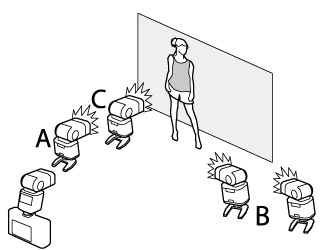
 Flash control mode (group A)
Flash control mode (group A)
 Flash control mode (group B)
Flash control mode (group B)
 Flash control mode (group C)
Flash control mode (group C)
Choose flash control modes for groups A, B, and C. [TTL%] is available for groups A and B only.
 Flash compensation/output (group A)
Flash compensation/output (group A)
 Flash compensation/output (group B)
Flash compensation/output (group B)
 Flash compensation/output (group C)
Flash compensation/output (group C)
Adjust flash level for the selected group according to option selected for flash control mode. Note that the full value may not be applied if the limits of the flash control system are exceeded.
 Flash mode (TTL)
Flash mode (TTL)
Choose a flash mode for TTL flash control.The options available vary with the shooting mode ([P], [S], [A], or [M]) selected.
 icon displayed when the shutter button is pressed halfway indicates that the flash will fire when the photo is taken.
icon displayed when the shutter button is pressed halfway indicates that the flash will fire when the photo is taken. Sync
Sync
Control flash timing.
 Zoom
Zoom
The angle of illumination (flash coverage) for units that support flash zoom. Some units allow the adjustment to be made from the camera. Select [AUTO] to automatically match coverage to focal length when using optional conversion lenses.
 Lighting
Lighting
If the unit supports this feature, choose from the options below.
 Master
Master
Assign the master flash to group A ([Gr A]), B ([Gr B]), or C ([Gr C]). If [OFF] is selected, output from the master flash will be held to a level that does not affect the final picture. Available only if the unit is mounted on the camera hot shoe as a master flash for FUJIFILM optical wireless remote flash control in [TTL], [TTL%], or [M] mode.
 Number of flashes
Number of flashes
Choose the number of times the flash fires each time the shutter is released in [MULTI] mode.
 Channel
Channel
Choose the channel used by the master flash for communication with the remote flash units. Separate channels can be used for different flash systems or to prevent interference when multiple systems are operating in close proximity.
 Frequency
Frequency
Choose the frequency at which the flash fires in [MULTI] mode.